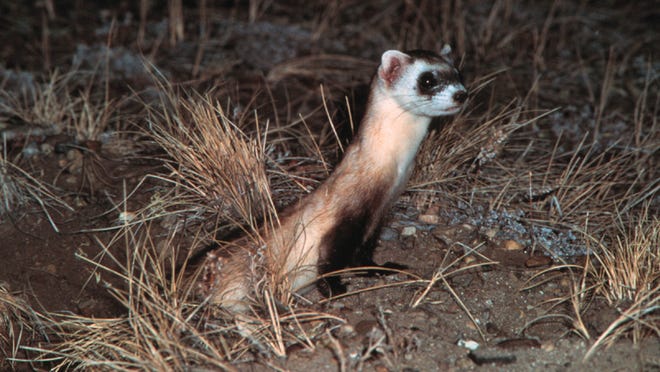Feds hope to restore New Mexico river trout by 2032 by rebuilding habitat on Gila River
 Adrian Hedden
Adrian Hedden
Short stretches of the Gila River and its tributaries extending from the desert mountains of southern New Mexico into Arizona are home to the struggling Gila trout, which federal wildlife managers attempted to recover since it was listed as endangered in 1973.
The rare river fish in southern New Mexico could be recovered from its dwindling numbers as the federal government finalized it plans this week to restore the species’ habitat and protect it from future population declines.
It was listed as endangered almost 50 years ago, calling for federal action as the U.S. Fish and Wildlife Service believed the Gila trout’s extinction was imminent.
More:Feds taking action against fungal disease that is pushing bats to extinction in New Mexico, US
Since then, recovery plans went through several revisions and the species was proposed to be down listed to threatened status, a lower class of risk than endangered under the Endangered Species Act.
But today, the Gila trout remains endangered and the latest plan expressed hope from the federal agency that the species can be recovered and removed from the list by 2032.
That could cost up to $15.6 million, per the plan published Wednesday, and entails restoring trout habitats in both states along the river.
More:Desert lizard could be protected by feds from oil and gas 'wreckage' following lawsuit
There were 23 known populations of the Gila trout along about 131 miles of riparian habitat as of April, per the plan, but genetic diversity served as a primary threat.
Genetic diversity is an issue with species recovery because if a certain lineage is genetically susceptible to a specific threat, that threat can pose a risk for the entire species if other lineages not susceptible are limited.
While recent efforts increased the number of trout in the wild, its distribution was constrained, per the report, meaning genetic diversity could remain limited.
More:Would protecting a rare bird in New Mexico threaten the state's oil and gas drilling?
This was because of a lack of suitable habitat for the fish, the report read, caused by invasive species, climate change and human activities and industrial development.
“Recovery actions implemented to date have greatly improved redundancy by increasing the number of populations of Gila trout,” read the report. “However, spatial distribution of populations is constrained by the geographical distribution of currently suitable habitat for the species, due to both human-induced and natural factors.”

In New Mexico, most of the Gila trout populations are in the Gila and Aldo Leopold wilderness areas in the state’s bootheel region spanning rural areas like Catron, Grant and Sierra counties.
More:Oil and gas impacts lead to lawsuit for federal action on lesser prairie chicken protection
It was first observed in New Mexico in 1970.
They grow to about 9 inches long, known for a distinct yellow-golden color on its body with fins slightly longer than other western trout, per a report from the U.S. Geological Survey (USGS).
Gila trout live about four years, the USGS reported, spawning in spring or early summer.
More:Thousands of animals are killed on New Mexico roads. What is the State doing about it?
Their reproduction requires clean, course gravel and continual stream flows, per the USGS, which could be threatened by degradation and drought along the river system where it dwells.
“Persistent, viable populations of Gila trout require perennial stream flow, which must be adequate to maintain sufficient habitat diversity and volume to support all life stages of Gila trout,” read the Fish and Wildlife Service’s recovery plan.
“The threat of local extinction of native salmonid populations increases with isolation and decreasing population size.”
More:Oldest species of tree-climbing reptile discovered in New Mexico
A report from the Center for Biological Diversity also pointed to risks to the trout from wildfires, a worsening environmental concern believed to be driven by human-made pollution and subsequent climate change.
This year, the Hermits Peak Calf Canyon fire and the Black Fire torched more than 300,000 acres each in New Mexico – the two biggest wildfires in New Mexico’s history.
Weather events like wildfires and floods, the report read, along with the Gila trout cross-breeding with other non-native fish species, led to continual declines in its population in the decades since it was listed.
“Forest fires (that now burn more severely than they did historically) and associated fire suppression activities also pose a threat to Gila trout populations,” the report read. “Although populations have increased since listing, threats to the Gila trout still exist and over the past decade, declines due to forest fire and hybridization have taken place.”
Adrian Hedden can be reached at 575-628-5516, achedden@currentargus.com or @AdrianHedden on Twitter.